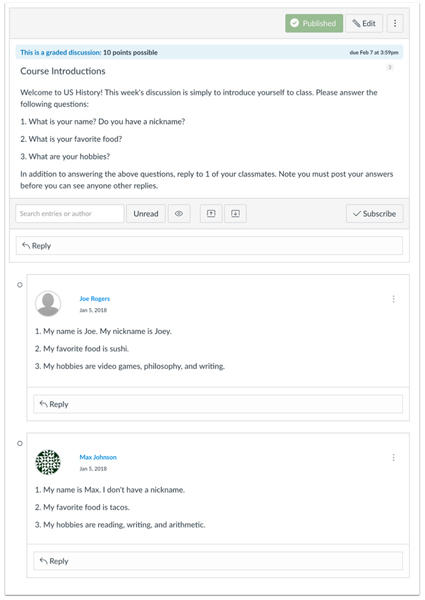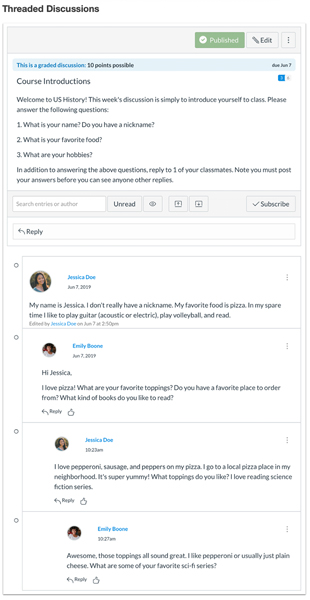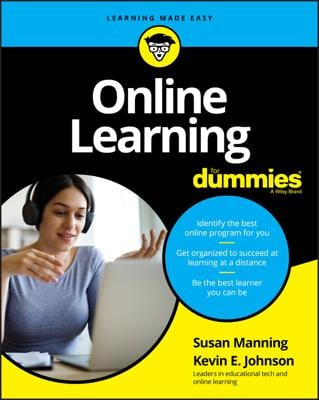Why you’re asked to discuss
No doubt you’ve heard the expression “Practice makes perfect.” It makes perfect sense if you’re studying keyboarding skills or French pronunciation, but seeing how this works is a little more difficult when you’re studying a subject like economics or world literature. Furthermore, in an online course, it’s impossible for the instructor to see learners practicing, right?Not so! Online discussion is one of the methods instructors use to witness your learning.
Here’s why:- Discussion shows you are reading. When you answer a discussion question and refer to your assigned readings or textbook, you demonstrate to the instructor that you’re actually reading the material.
- Discussion shows your ability to think critically. Many instructors want you to take the content and break it down, analyze it, put it back together in a way that is meaningful, and add an interpretation of how this works in the real world. This is critical thinking! When you participate in discussion, you show your ability to think critically.
- Discussion helps you learn better. It’s not enough to read, cite, and move on. Instructors want you to personalize and internalize the information. In fact, this is one of the ways adults learn better and faster.
- Others benefit from discussion, too. In the constructivist classroom, everyone wins when you take a topic and develop it fully. When you add your insights and interpretations, the rest of the class is able to consider whether they agree or disagree and, most importantly, why.
Discussions organized in different ways
Discussion is a conversation that occurs online and requires more than one person. For example, John puts forth an idea to which Chris responds with an example supporting his idea. Others join in the conversation, too. Sally suggests an alternative view to what John has written with an additional reference to the literature. Pat asks a question for clarification, forcing John to find another way to explain his original idea. All of this gets rolled together for a more complete understanding of the content. By the time the discussion runs its course, the readers and authors have looked at the subject matter more thoroughly because of the diversity of views.Depending on the learning management software, you may see your conversations displayed as small pieces connected to one another in a couple of ways: chronologically or threaded. Each piece comes from an individual speaker and is a piece of written text, or post:
- Chronological posts: The posts may be connected in a linear fashion, following one another in chronological order. This figure shows what this looks like.
 Canvas discussions: A discussion in chronological order
Canvas discussions: A discussion in chronological order- Threaded posts: A threaded discussion displays the conversation in a different graphical fashion: When you look at the display, you’re better able to see how ideas connect to one another. The dates may seem out of order, but not if you follow the conversation as if it were in outline form. Text that’s indented is directly related to the post above it. This figure shows a threaded discussion.
 Canvas discussions: A discussion displayed in threaded fashion
Canvas discussions: A discussion displayed in threaded fashionDoes it matter whether your software shows the discussion in threaded or chronological fashion? Not really. What matters is that conversations are occurring between learners and that you can follow these conversations.
Many learning management systems allow you to change how you view discussions. You control whether you see them in threaded or unthreaded fashion according to your settings. If you have this option, play around with the settings until you find the system that works best for you.
Discussion requirements
Each instructor has their own expectations regarding discussion and participation. You may find these expectations in several places:- The syllabus: Chances are good that the instructor lists discussion as a component of your grade in the syllabus. They may say something like this: “Participates in discussion by posting an initial statement and responding to two other peers each week.” Read those statements carefully to determine what is expected.
- The instructions: You most likely have a page in your course that describes what you should do in the discussion area; you should be able to find a link to this page from the course’s main page. The questions you’re expected to answer may be listed there. Often this is where the instructor reminds you of how much to write and how to post. For example, you may read, “Answer one of the following questions in 300 to 500 words. Be sure to reference one of our assigned readings. Before the close of the module, respond to two of your fellow students’ posts.”
- The grading scheme and rubric: These items may be on a separate page within your course, or they may be woven into either the syllabus or the instructions. The grading scheme is the overall plan for how you are graded. A rubric spells out what counts in an individual assignment. For example, a rubric may state that you need an on-time post of 300 to 500 words with proper citation, and you must respond to two peers.
Avoid overposting
Overposting can occur in two manners: writing too much and responding too frequently. Both have consequences.- Writing too much: When your instructor asks for 300 to 500 words and you submit a three-page essay, you have overposted! The result is that your classmates won’t read through your ideas, and no one will want to discuss them. You may be penalized for overwriting, too.
Before posting, count your words. You can do this in Microsoft Word by looking at the bottom of the document. Toward the left side you will see page x of y and then the number of words. You can also find this information by choosing File-->Info (or Properties) from the menu at the top. You may need to isolate (highlight) the paragraph you want counted. In Google Docs, choose Tools-->Word Count from the top menu bar.
- Responding too frequently: You don’t need to respond to everyone’s posts. When your instructor asks for a minimum of two responses to others, they may be hoping for four or five, but not 15 or 20!
Think of this in terms of the face-to-face classroom. How do you react to a student who has something to say to everyone’s comments? Doesn’t that person seem to be an attention-seeker? After a while, aren’t the ideas a little self-serving? Do learners begin to roll their eyes when the commenter opens their mouth?
The same happens when learners overpost. However, in the world of online education, you can choose to avoid reading what those who overpost have to say. This is not always a good thing.
We like to encourage good discussion with quality posts. Think of contributing 10 percent of the comments. Discussions can grow exponentially, and you don’t want to be the person whose posts no one reads because you’re too prolific.

